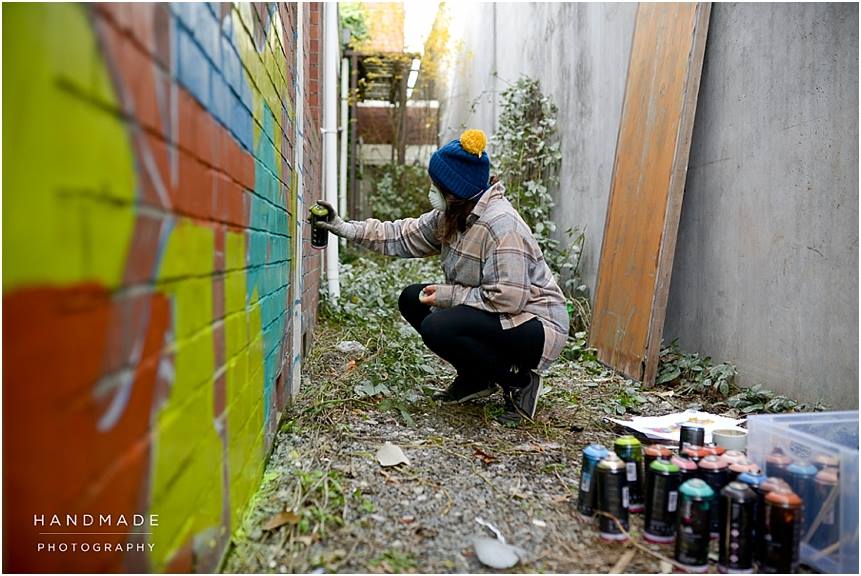Kophie Hulsbosch might be softly spoken, often punctuating sentences with gentle laughter, but it is quickly apparent that she is driven by a desire to use her creative output for good. I was introduced to Kophie when I was preparing for our story about the RAD Collective, and as I got to know more about her, I discovered the diversity of her practice, from her clothing brand, Future Apparel, to illustration, via graffiti and surrealistic painting. In her own words, she isn’t someone who ‘just sits back and lets stuff happen’, and as such Kophie’s output is always entwined with her socio-political and environmental beliefs. But her work also reveals the exploration of identity as a constant theme to be unpacked. This exploration is not solely an act of self-reflection, there is a sense Kophie is interested in identity in a broader stroke, in what it means to be an individual amongst a collection, not just in her quirky characters and portraits, but also in the inherent nature of graffiti, and her vocal concerns about consumption, our complicit involvement and its impact on our surrounding environment. Another example of a young Christchurch creative emerging from the influence of urban art to explore a diverse range of artistic approaches, Kophie Hulsbosch is a reminder of the potential to connect a creative impulse with a desire to change the world, regardless of the scale of such actions. We sat down and discussed how art became a vessel for her beliefs, how these ideas were fortified in her practice, and the dark side of the ‘fast fashion’ industry…
So Kophie, let’s pretend this is a superhero movie, what is your backstory?
I came from Wanaka, surrounded by the outdoors and people skateboarding. Then, when I was about ten, I moved to Christchurch. I never finished high school, I dropped out in year eleven, it just wasn’t for me. I worked terrible jobs and I just kind of figured out what I wanted to do through that. In high school, I had only ever really studied in my art classes (laughs), so after working those horrible jobs, I decided to do the foundation course in design at ARA. I loved the course and decided to continue with graphic design. My goal was to be self-employed, but I also wanted to use art for social commentary, mostly environmental issues. After I completed my Bachelor of Visual Communication, I received a scholarship to do an honours degree in Media Arts. At the same time, I decided to launch a business, making use of the facilities at ARA and combining everything I had learned; drawing, branding and graphic design. I wanted to make some sort of environmental comment with my work, so after discovering that the clothing industry was the second most polluting industry in the world, I decided to re-purpose clothes. I guess I’m not the sort of person to just sit back and let stuff happen! (Laughs)
When did that drive crystallise? Did it take a while for you to realise the direction you wanted to go, or was it engrained in your worldview from a young age?
Well, I enrolled at ARA because I just wanted to get better at drawing. But when I was 11 or 12, I became a vegetarian, and that sort of set off my ethical conscience, because once you start learning about one issue, all these other things pop up that show how so many things are interconnected. I started learning about the impact on the environment of animal agriculture, and the associated social issues, and then when I did a philosophy paper at ARA, I started finding out how the world works and how messed up a lot of things are, and I started exploring how to potentially change it…
Importantly, you have utilised art to engage with those issues. Was that just something that made sense to you, to communicate and explore ideas? Is drawing a way for you to problem solve?
I’ve always known it is one of my strengths, in Maths or English at high school, all I would do was draw on my hands, and I would just constantly get in trouble. I just think it’s the only voice that I have, or at least it’s the best outlet I have to get the message across.
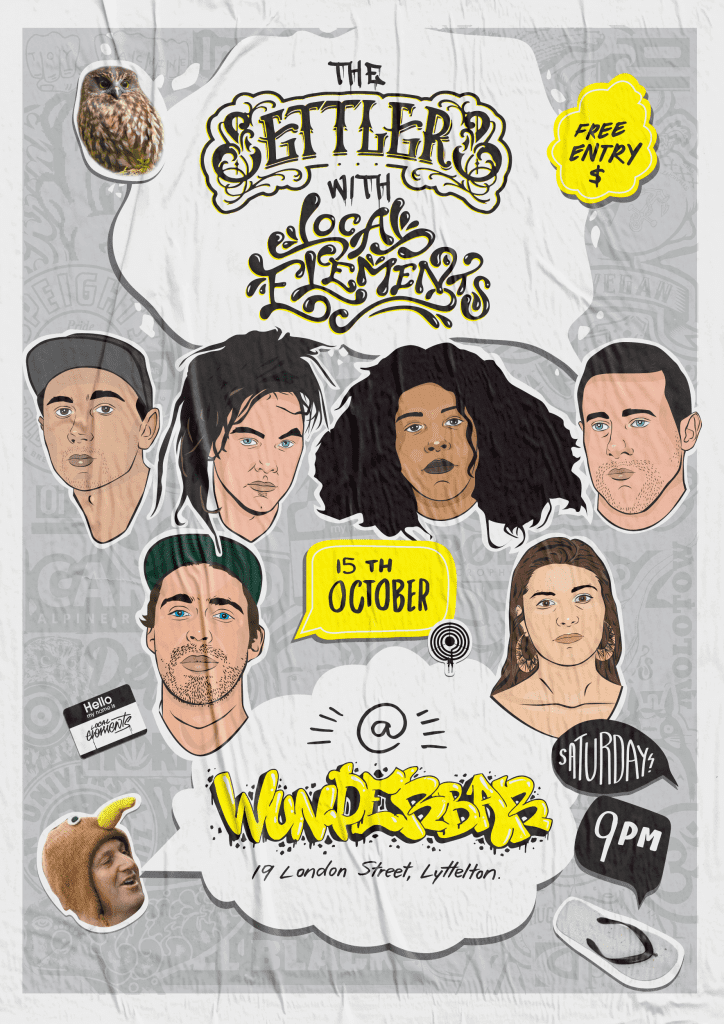
One of the first things I noticed with your work is the diversity; illustration, graffiti, figurative drawing and painting, design work, branding… Is it just in your nature to constantly explore different approaches, or is it necessary to express different ideas?
I think I just always want to try different things and learn. But sometimes I think I probably should focus more on one thing! (Laughs) But I just want to be creative in any way, and I mean, you can learn anything off the internet now. I taught myself how to sew on YouTube! There are infinite possibilities…
In some ways, the need to pigeon hole yourself has been broken down by the possibilities of the digital age to explore ideas and cross-pollinate. But would you proclaim yourself to be any one thing more than anything else?
I mean I started everything from drawing and illustration, just weird, obscure drawings and naked women! (Laughs)
There is a definite sense of the surreal or fantastic in some of your work, but there is also often a grounding in some sort of psychological reality, an exploration of identity, or that sense of social awareness that you’ve already talked about. Do you try and find a balance between intentionally expressing ideas and a subconscious approach?
Every project is different. Sometimes I think when it is from my subconscious, I look at it and I’m like, how did that come out of my head? But with graphic design work and commissioned projects, it is more controlled, I know what I’m doing. Most of the free stuff is influenced by hip hop, hip hop music and graffiti and those cultures.
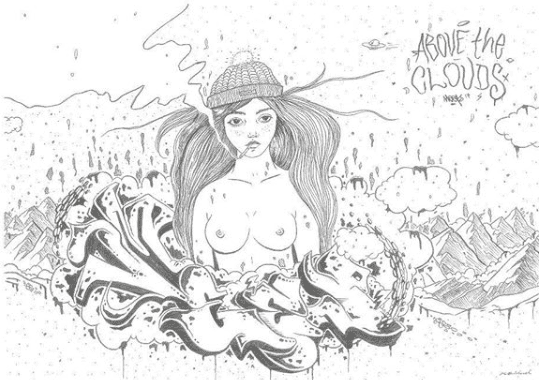
What do you find the most attractive element of graffiti? Is it the creative element, the search for style? Is it the idea of the social communication? Or is it the act, the adventure of graffiti?
I think all three; I love the thrill, I love the idea that you can do whatever you want, whenever you want, and make spaces come alive. You see little areas and you’re like, that could be a face, or that could have a personality. The style is important as well, I mean I look up to people who have a really defined style and I always think of style over spots, personally…
With graffiti writing, obviously the issue of identity is a central concept as well, albeit couched within the expression of style. Do you make the connection between letterforms, style and the idea of identity?
I think my letterforms are probably the weakest element of my art, so I like to practice them a lot. But I try and paint every piece differently, so I never really have a particular style. Some of my stuff is quite creepy, and creature-like, but then other times it can be quite straight and sort of masculine. I like to make it look like a girl didn’t do it, whatever you think girly graffiti looks like, like love hearts and pink colours… I like to make my stuff look not necessarily feminine…

The discussion of gender has long been a part of the analysis of graffiti, at least from a scholarly approach, because there is this perception of graffiti being a very masculine pastime. When you think of the likes of Lady Pink, there is an acknowledgement of gender in her moniker. But, your name doesn’t have to be representative of reality, you can mask your identity when you write graffiti. By developing a personal style, that in itself can become the identity, is that your approach?
I guess so, because on my Instagram, and it is just my art Instragram, I never really post selfies or pictures of myself, because I like the idea of people not knowing who I am, if I’m a girl or a boy. People do tend to have a judgement if you’re a girl.
The pursuit of style can be all consuming, and with the digital age, the number of available influences has become so wide-ranging, that it seems harder to develop that distinctive signature in some ways, everything has a danger of seeming derivative, just because more people have seen more things…
The internet! (Laughs) I know back in the day, each town had a certain style, you would know if it was New York graffiti or whatever. Whereas now everything is just a massive collage of everything; every era, every style, and it is harder to find that identity, because there is so much that’s already been done. You have to think outside the box all the time, or just accept the fact that everything’s being re-purposed.

How did you become a member of the RAD Collective?
I was making clothes at ARA just before a pop-up shop. I was really stressing out and just running around the classroom getting things done. Becca and Jimirah (founders of the RAD Collective) came in to see one of my other mates, and I just had my clothes on the table and they were looking through them, and they were like: ‘Wow, this is amazing!’ Then a few months later they gave me a message on Facebook and said: ‘We are doing a thing. Do you want to be a part of it?’ And I was like, ‘Yeah!’
What do you personally see as the greatest benefit of the RAD Collective? That type of network, people with different skills, and the energy it generates, must be really helpful in the transition from a learning institution into the ‘real’ world…
They have been so amazing. They have just uncovered countless opportunities for me. They look out for me so much. They are just always so supportive, which is really cool. They are trying to suss out a space, find walls and organise exhibitions… You can’t do all that stuff by yourself…
That story about meeting Becca and Jimirah also introduces your clothing brand, tell us a little bit about Future Apparel…
As I said before, the main drivers of the brand have been the environmental and ethical issues, things like the conditions for workers overseas, and the number of animals killed for materials. The crazy thing that I can’t understand is the environmental and ethical impact of the day to day things that we do. By consuming in the over the top manner we do now, we keep making it worse and worse and worse, but we kind of just accept it. I know people notice things, but we are so used to the consumer culture we live in, it feels like you have to abide by it…
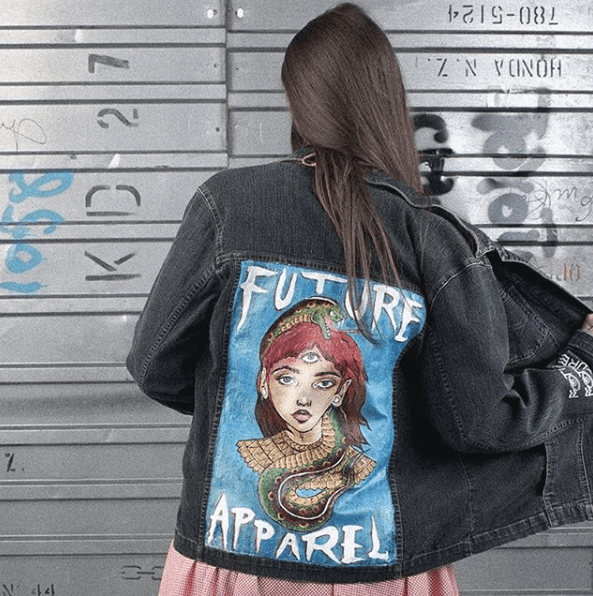
There is an unwillingness to explore alternatives because they seem too hard.
Yeah, is it cognitive dissonance? Is that the one? (Laughs) Through Future Apparel, I want to change the mindset. My ultimate goal is to create a different culture around how we buy and consume, to encourage people to think about the actual human aspect of things when you buy. Like, with clothing, most of us probably think it jut appears on a rack by magic, you don’t see any of the process behind the item.
Is it important to find the balance between your creative outlet and the real-world application; to not be dragged down by the realities of the political side, to ensure that you remain inspired by your creative outlets?
Yeah, it’s a constant battle: I want to change the world, but then sometimes I don’t think I can do anything, and that the world’s fucked! (Laughs) Sometimes you feel isolated, because you see people around you and you tell them things, and they are like, oh that’s terrible, but they don’t really do anything, they don’t care enough to make it their life to change the world for the better…
I feel like it is a result of how we receive and process information in the digital age. The internet allows avenues of widespread and instantaneous communication, but we seem to use them for the worst possible things. The potential is so amazing, but the reality can be so mind-blowingly frustrating! (Laughs)
Memes! (Laughs) I think it is crazy how we have all this information at our finger tips, but it is used, I’m not saying by everyone, but it is used by so many people to just watch silly videos. I can post a selfie on Facebook and get 130 likes, and then I share something about the planet, about the extinction of sea creatures, and people give me like maybe two likes! I don’t know…
You must have learnt a lot about the tricks of the corporate world, what things have you discovered that have fed into Future NZ as a concept?
I have looked at the idea of green-branding and green-washing, and how a lot of brands are using these ideas to drive profits, even though they aren’t necessarily a ‘green’ brand, so that was something I wanted to avoid…
Explain the idea of green-washing a little bit…
So, with green-washing, someone like Apple Computers say they recycle their products for new computers, and they have this whole eco-brand called Apple Renew, but they are also bringing out new products every couple of months and trying to push consumerism while also trying to have this other identity of being eco-friendly…
So, they are producing a semblance of a response to an issue they have helped create and are still creating…
Or say toilet paper companies who say they are donating one cent from every sale to help save forests; it is like a pretend persona, just to try and drive sales. One of my lecturers suggested there is a chance to do some further research, he thinks the whole sustainability approach can’t work under the capitalist construct, that it will always be undermined by profit and exploitation, even if it is green-branded or a green product…
It’s not a fair battlefield, right? The field is being created by those who gain most. How do you fit your conception of graffiti and urban art within the issues of sustainability and ethical consuming? Do you see it as a natural way to address that uneven battlefield?
I wouldn’t say my graffiti is eco-based, because I know spray paint isn’t the best for the environment, but I have made paste-ups in the past, and I always have ideas of big signs I can put up everywhere, like guerrilla campaigns around the city. I do want to do that sort of thing, but I’m just figuring out how to get it across. I think it could be a really good form of getting a message out there. You are forced to look at it, with social media you can just scroll past it, like ‘meh’, but if it is in your face in the streets, if you are driving past it every day, you might think about it…
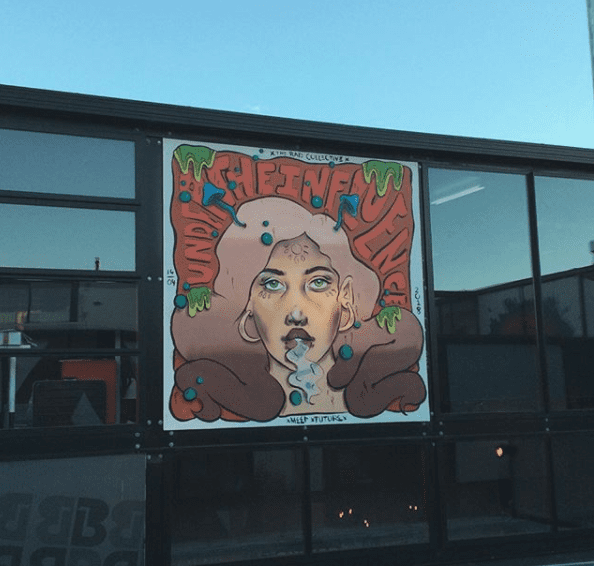
You recently had something of a run in with a well-known fast fashion company, what happened?
My friend sent me a picture of basically my exact design on a fast fashion shop piece. I didn’t really think much about it, but then I was lying in bed and I saw the image I created because I had put it on my wall, and I was like, it is exactly the same, like exactly the same: same colours, same font! I put it on Instagram and my friends got way more worked up than I did, Becca wrote a big post about it, and it got around a bit on Facebook. The New Zealand Herald contacted me, but I didn’t talk to them just in case, you don’t want to get sued. Then I found out about another girl from Australia whose work they blatantly ripped off as well, but she didn’t do anything about it, she couldn’t be bothered. So, I emailed them, I said, I think you’ve copied my design, and they basically replied that it was a coincidence and showed me their process. (Laughs) But they said like, ‘this was done at 11.50’. They gave an exact time something was done. When you’re doing your workbook process, you don’t write the exact time and date when you are doing it, unless there is something strange going on. But, I mean, it is what it is…
I guess in that situation, you have to decide how worthwhile the expenditure is, because it is a lot of emotional energy, right? But at the same time, it must be frustrating to think that as a result, companies probably get away with a lot, because their resources are greater. Did it also make you think about the role of social media? How when you post something, it is visible anywhere around the world and it immediately becomes so public?
I instantly thought of the recent thing with H&M and Revok, the graffiti artist, like they think they can just take anyone’s work because they are the rich big guns and they kind of have immunity because they are so well-known. But yeah, the most frustrating thing was the mass production side; they are making money from exploitation of labour and other ethically dubious practices, where I make one-off designs, re-purposed from fast fashion! (Laughs)
It’s the exact antithesis of what you want Future Apparel to be and to be associated with, which must have made it so much more frustrating than someone who was maybe trying to enter that world. In many ways I would hope it has steeled your resolve to opening people’s eyes to the realities of fast fashion and the alternative options that are available…
Yeah. I also think about how sustainable clothing tends to be elitist in a way, like it is always quite high-end and targeted towards more well-off people. But I wanted to also use street wear, skateboarding, hip hop, and cultures like that, and incorporate them all and make something for youth, because I feel like it’s a missed market. I want to make it affordable for that group and remove the elitism. So, like I know a lot of people my age, they care about this sort of thing, and they want to buy sustainably, but it is out of their price range, they are often studying and would never be able to afford one-off nice items…
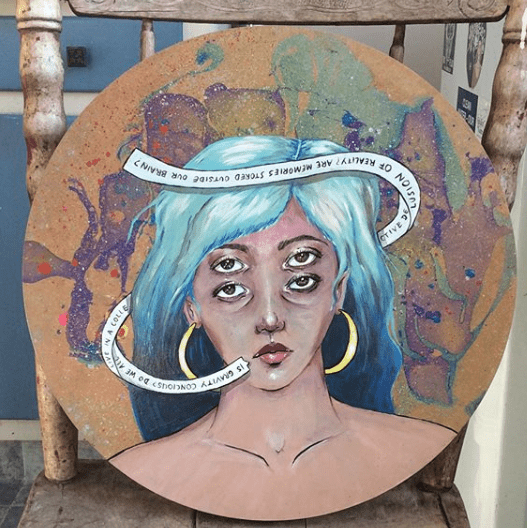
You obviously have some long-term goals, but what do you have going on in the short term? You’ve got a few things on the go, right?
I’m illustrating a children’s book for the Crusaders (The Super Rugby franchise), it’s going to be in every school in New Zealand, which is pretty cool! But I’m not allowed to make the horses smoke cigarettes! (Laughs) The Under the Influence exhibition was obviously a few months ago, I exhibited two portraits and painted live at the event. Some of my projections were also in the courtyard. I haven’t worked on Future Apparel much, (laughs) but hopefully I will find time to do that. I’m also working with a sustainability company, but I can’t say much because they haven’t got copyright yet…
You’ve got some mural work?
Oh yeah, I’m doing a mural at BizDojo!
With that many things on the radar, have you reached that goal of self-employment? Are you sustaining yourself through your creative outlets?
I’ve got the student allowance at the moment, without that I’d be screwed! (Laughs) I’m doing a business course as well…
As an artist, and being that your ethical concerns are pretty central to your approach, do you find that you are an odd one out in that environment? I am always interested in how ethics and morality are incorporated into commerce-based education…
Yeah, I just can’t mentally justify having a business without making it for the greater good, like not just for profit, I just can’t wrap my head around being driven by making money at all costs…
There are probably a lot of people who are exactly the same way and yet there are those who see business as a by-word for profit-making, so it is an interesting challenge to become comfortable in an environment and reach the goals that you’ve set for yourself…
Yeah, maybe that could be something, changing the consciousness of business, maybe its compulsory to have some profits go to a charity, or help impoverished communities. I mean another big thing I looked at was the idea that profit was just another word for stealing…
‘Making’ money is really just ‘taking’ money…
I still think the majority of people think that if you are not making money, you are not doing anything. That’s something I struggle with… (laughs)
It’s the idea that our value in society is based on the money we make, which is flawed thinking…
Money is evil! (Laughs)
That’s sounds like a pretty good sign-off! Thanks for talking to us Kophie!
Follow Kophie on Instagram via @kophie or @future_nz, or check out her website https://www.yoitskophie.com/
Featured image credit: Handmade Photography

